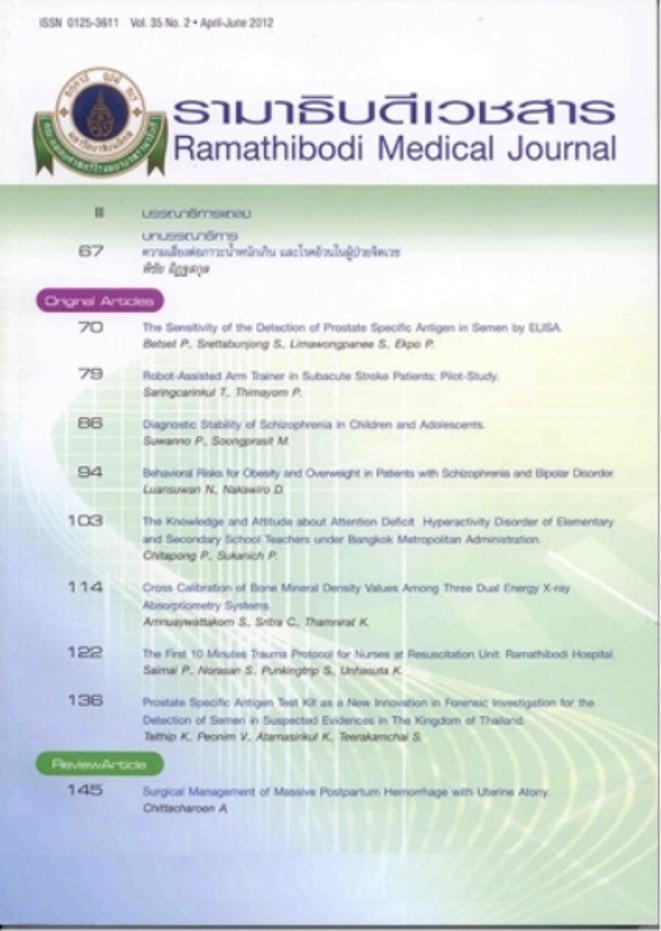The First 10 Minutes Trauma Protocol for Nurses at Resuscitation Unit: Ramathibodi Hospital
Keywords:
Protocol for nurse, The first 10 minutes trauma care, Resuscitation unitAbstract
Objective: To evaluate the effect of implementation the first 10 minutes trauma care protocol for nurses in resuscitation unit, Ramathibodi Hospital, Thailand.
Methods: This descriptive research included of 30 from nurses who work at resuscitation unit. All participants had been attended two hours lector done by researcher. Lecture contents consist of the first 10 minutes trauma care protocol and 13 flowcharts for trauma care. The protocol, developed by Krongdai Unhasuta and Thai Trauma nurses network, consist of practice triggers, follow the principles of Advanced Trauma Life Support (ATLS) and knowledge triggers, categorize of resuscitation management (assessment, management and monitoring). An evaluation of protocol was done one month later by reviewing medical record, nursing documents and satisfaction questionnaire.
Results: The result found that all participants satisfied this protocol regarding helpful to manage trauma patients systemically, eliminate error and reduce time in saving life. The other findings found that most nursing document focused on patients’ severity, medical orders and treatments, but less concern about patient position, warm keeping and giving family information.
Conclusion: The effect of implementation the first 10 minutes trauma care protocol for nurses in resuscitation unit was found that nurses satisfied a trauma care protocol. Resuscitation management was not complete especially documentation. These finding suggest that specific protocol with short course training and regular evaluation will improve quality of nursing care.
References
Rattanalert S, Intharaksa P. Handing Distressed Relatives. In: Rattanalert S, ed. Head Injury: Head Injury: Hospital Accreditation (HA) Support Systems. Bangkok: O.S. Printing House; 2003. (in Thai)
Piangkaew E, Phuenpathom N. Head Injury. In: Phuenpathom N, Maipang M, Rookkapan K, eds. Textbook of Emergency Medicine. Bangkok: O.S. Printing House; 2002. (in Thai)
Atanavanich S. Multiple Injury. 1st ed. Bangkok: Varanon Enterprise Ltd., Part; 1999. (in Thai)
American College of Surgeons Committee on Trauma (ACS COT). Head Trauma. In: American College of Surgeons, eds. Advanced Trauma Life Support Program for Doctors. 7th ed. Chicago: American College of Surgeons; 2004.
Sriussadaporn S, Primary Survey. In: Siritongtavorn P, Chuthatisith S, Tonmukayakul A, eds. Trauma Surgery 12: Fast Track Treatment in Emergency Room. Bangkok: Ruenkaew Printing; 2002. (in Thai)
Gruen RL, Jurkovich GJ, McIntyre LK, Foy HM, Maier RV. Patterns of errors contributing to trauma mortality: lessons learned from 2,594 deaths. Ann Surg. 2006;244(3):371-80. doi:10.1097/01.sla.0000234655.83517.56.
Spahn DR, Cerny V, Coats TJ, Duranteau J, Fernández-Mondéjar E, Gordini G, et al. Management of bleeding following major trauma: a European guideline. Crit Care. 2007;11(1):R17. doi:10.1186/cc5686.
Sakolsatayadorn P. The problem of caring for the multiple trauma patients. Thai Journal of Trauma. 2002;18:38-46. (in Thai)
Fitzgerald MC, Bystrzycki AB, Farrow NC, Cameron PA, Kossmann T, Sugrue ME, et al. Trauma reception and resuscitation. ANZ J Surg. 2006;76(8):725-8. doi:10.1111/j.1445-2197.2006.03841.x.
Jones LO. Chest trauma. Anaesthesia and Intensive Care Medicine. 2005;6(1):310-2.
doi:10.1383/anes.2005.6.9.310.
Cranshaw J, Nolan J. Airway management after major trauma. Contin Educ Anaesth Crit Care Pain. 2006;6(3):124-7. doi:10.1093/bjaceaccp/mkl015.
Dutton RP. Fluid management for trauma: where are we now? Contin Educ Anaesth Crit Care Pain. 2006;6(4):144-7 doi:10.1093/bjaceaccp/mkl025.
Unhasuta K. Initial assessment for nurse, 2006. Available from: https://www.thaitraumanurse.com/download/article/ATLS Nursingmanagement.pdf.
Dow A. Management of patients with major trauma. Anaesthesia and Intensive Care Medicine. 2005;6(9):305-8. doi:10.1383/anes.2005.6.9.305.
Hassan A, Tesfayohannes B. Clinical assessment of major injuries. 2006;24(6):185-189. doi:10.1383/surg.2006.24.6.185.
Unhasuta K. The effect of implementation of a clinical nursing practice guideline for life-threatening injured-patient on resuscitation management in emergency room, 2008. Available from:
https://www.thaitraumanurse.com/download/article/2009/Document/Implement_life_threatenCNPG_Thai.pdf.
Barbiasz JE, Hunt V, Lowenstein A. Nursing documentation: a format not a form. J Nurs Adm. 1981;11(6):22-6.
Termchit-aree J. An Analysis of Factors Related to Problems of Recording the Nurses Note of Professional Nurses in General Hospital, Bangkok Metropolis (Master’s thesis). Bangkok: Department of Nursing Education, Chulalongkorn University; 1987.













